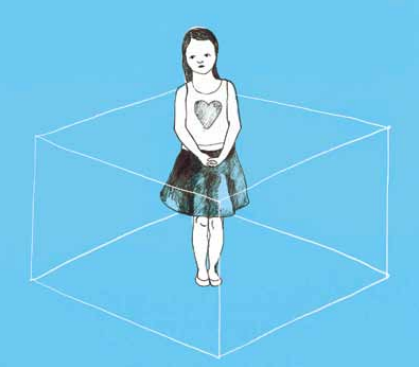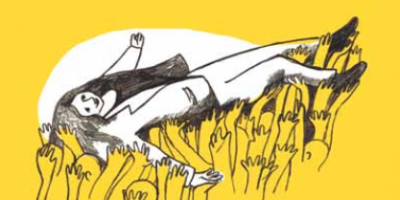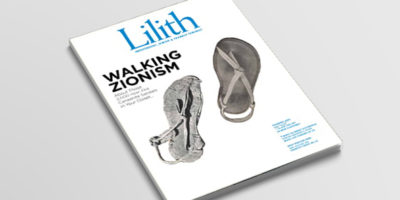
in a corner of the Hebrew school classroom
In fifth grade, resisting a bad lesson plan: is she Jewish or is she American?

Illustrations by Hila Peleg
“Pick a corner,” the substitute said.
Not a single student moved.
“Which label best describes you?” The pitch of her voice and the hem of her dress were considerably higher than those of our regular Hebrew school teacher.
The substitute had hung a hand-lettered sign in each corner of this rarely used classroom, where the small desks and chairs had been pushed out of the way. My classmates, 10-year-old boys and girls, looked at one another, at the signs, and at the substitute teacher commanding the center of the room, pointing to each corner in turn. This was not like regular Hebrew school.
We typically gathered at the synagogue on Monday and Wednesday afternoons to learn to read Hebrew words right to left, dipping down to catch the vowel markings under the consonants. We studied conversational phrases of modern Hebrew: The dog is in the house. The man on the kibbutz plants trees. Under the tutelage of our regular teacher, Mrs. Cantor, we practiced singing the lilting, mournful tunes of the Shabbat prayers, sitting or standing as required by the holiness of the words, and on Yom Kippur confessing our unknown failings against God. Mrs. Cantor kept time, slapping her palm against her massive wooden desk.
I repeated the tunes and words of the prayers by rote until they merged into familiar ritual chants. I learned their places in the sequence of the service and the briefest explanation of their purpose.
This prayer exalts the holiness of the Lord.
This prayer expresses thankfulness for His gifts.
This prayer declares that You are the Lord, our God.
And let us say, Amen.
We didn’t discuss the translations, printed in English on the facing pages. No thoughts of why we were dust and God was everything. No wondering what we needed God for, other than to listen to prayers we didn’t understand. He gave us life and he gave us Torah — His words and rules to live by — and that was plenty.
Today’s activity had started out as an exciting reprieve.
“Pick a corner.” The substitute acted like it was a game, but it felt like a test.
Each corner had a different sign: Human Being; Boy or Girl; American; and Jew.
“It’s OK to think about it,” the substitute said, since none of us had moved.
We weren’t stupid; we knew what we were being asked to do. Most of us shuffled off to the Jew corner; a few of the more rebellious boys went over to the American corner, and then there was me, hanging back, probably chewing the end of my one long braid.
Why Human Being? I thought. We’re all human beings. It’s not like the class was half kids and half dogs.
The Boy or Girl sign was just embarrassing. I wasn’t going to stand under a sign to say, “Look at me. I’m a GIRL.”
That left Jew or American.
The teacher asked me again, now alone by the door, to pick a corner.
I wouldn’t reject my Jewishness any more than I would reject my name or my face, but I couldn’t disown my American identity either. My Americanness is what protected me.
I shook my head. No.
A few months earlier, for show-and-tell, I’d brought in a photo album I’d made from stapled green construction paper, the photos taped to the rough pages. The original prints of a Polish concentration camp came from undeveloped film my dad had taken off a Nazi soldier after he — my father — had been liberated. I turned the pages to share the black-and-white images: an emaciated man standing beside the impenetrably dark hole of an oven; mounds of bodies like scrawny felled trees stacked for burning.
Here we were, the Jews.
I wish I could reconstruct the state of mind that led me to drag the piano bench over to the guest room closet, climb up and pull down the small, scuffed leather valise from its place on the high shelf next to our vacation slide carousels, and sort through the pictures and documents, picking out the photos and arranging them in a sequence that made sense to me.
After taping down the white-bordered photos, I made a book and packed it up to bring to Hebrew school. I doubt my mother knew about this project. She wouldn’t have let me risk damaging these evidentiary photos. And she would have had the sense to keep them from being shown to a class of 10-year-olds, mediated only by another 10-year-old: Here we all are in Hebrew school, the Jews; and here we are on these pages, the Jews.
I knew from conversations among adults at dinner that there were no “us Jews” and “those Jews.” There were just, always together, Jews.
I don’t remember what I said, or if my classmates raised their hands to ask questions, or if Mrs. Cantor intervened or let me finish “showing” the photos and “telling” God-knows-what.
But I do remember the afternoon the substitute teacher led us out of our regular class to the room where someone had moved the furniture. What kind of a teacher asks a group of Jewish kids to intuit the desire of an authority figure to obediently line up in a corner under a sign that says Jew? Had we learned nothing?
Like most kids, my favorite Jewish holidays were the ones that were most action-packed. They happened to feature people trying to kill us, even if they didn’t finish the job. Story after story of not-completely-successful attempts to kill us off.
We seemed so unlikable.
We weren’t supposed to care about that. We were supposed to care only that God continued to swoop down and save us.
But the reason we were hated was that we believed in a different God, so God made picking the Jew label problematic.
But I couldn’t pick the American corner. I was a Jew. Not just because I was taught that the Nazis didn’t care what kind or what fraction of Jew you were. I liked being Jewish. I liked figuring out the code of our backwards alphabet. I liked raising my voice in prayer in concert with my classmates. It filled me with the power and comfort of belonging.
But I wouldn’t be bullied into the Jew corner any more than I could be forced to believe in the miracles from our holiday stories. What kind of loving God would go out of his way to keep a light burning for eight days, just to reward faith? A light is just a symbol, not a necessary thing in itself. Like a mother. Or a village. Was a light worth more than the lives of my grandparents and aunts and uncles? More than the lives of my cousins? Worth more than the lives of the people in the photos, the ones who didn’t look like people anymore?
Even at 10, I could see it was way past time for the substitute teacher to congratulate herself for leading us privileged, suburban kids through an identity-raising exercise. We were running late to translate Jerusalem cats chase dogs under the date trees.
I shuffled over to a spot halfway between the Jew and the American signs, and there I stood.
I couldn’t articulate this when I was 10, but in the post-war branding of the Holocaust — the cry of Never Again — God’s protection was never invoked. We instead rallied to self-determination and alliances. I knew my Americanness protected me. I don’t mean just physical protection, the conviction that we were safe on the Jersey Shore from the contemporary version of marauding Cossacks. I mean, my Americanness protected me from having to identify as helpless, unlikable, and friendless in the world. It protected me from the literalness of prayer. It protected me from a God who cared about his image more than about our lives.
Sari Boren is a writer and museum exhibit developer who has created exhibits for history, science, and children’s museums across the country. Her essays have appeared in Alimentum; War, Literature & the Arts; and psychologytoday.com.



